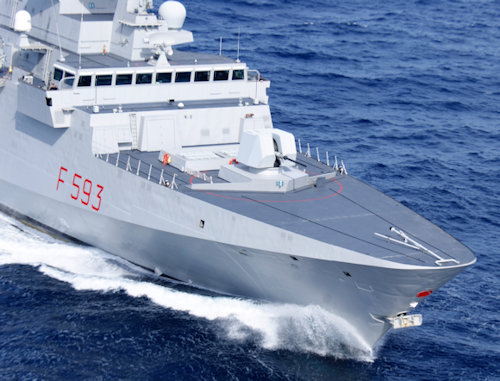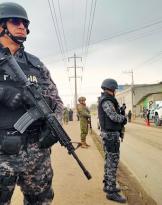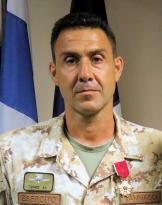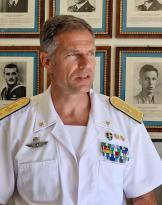There are interviews that just start taking a different route than you expected. Interviews that become stories and that bring out what may be important, unexpected, exciting and excellent behind a mission. To set the course, this time, is the frigate captain Francesco Pagnotta, commander of the European Multi-Mission Frigate (FREMM) Carabiniere of the Navy which tells the first months of the operation here.
Commander, what it means to be in command of the FREMM Carabiniere?
For me it means having crowned the dream I had since I was a child, even before starting my studies in the Naval Academy, that is to say commanding a military ship. Nave Carabiniere however is not only a military ship, but represents the last generation of Navy ships, the most modern and technologically advanced ships we can have in our country right now. In addition to the technological aspect, I am also proud to be the leader of a trained and motivated crew with whom I am facing a Naval Campaign of great importance for our country.
I am proud to embody, through naval command, the values and traditions of the Navy, but the activity we are conducting is not limited to just this: it is also an exhibition of Italian excellence through the organization of social, cultural and promotion of the image of Italy in collaboration with national diplomatic representatives and also an international showcase for Italian industry. It is a great responsibility that I feel about myself, but I dedicate all my efforts and my energies to this period of naval command.
What is the budget of the mission three months from the start?
The balance is definitely positive. Since December 20, when the ship has left La Spezia for this long Naval Campaign, there are many results achieved and I try to list them.
IThe first result is that of having contributed to one of the traditional tasks of the Military Marines and that is that of ensuring maritime safety in the sea areas crossed by the unit. These areas, ranging from the Mediterranean Sea to the Gulf of Aden to the Indian Ocean, are of significant importance for national strategic interests. The sea - humanity's common good - is vital and our mission is also to guarantee its free use.
The second result is related to cooperation and dialogue with international partners. There have been many moments of exchange, discussion and common growth with the Marines and Armed Forces of the countries we visited before arriving in Australia. At each stop we had the opportunity to host various military authorities and show the excellence of the Italian defense industry enclosed within the bulkheads of our ship. We also had the opportunity to carry out exercises with the navies of the countries we touched: a further element of growth in relationships, in knowledge, in mutual trust and mutual respect. These exercises also make it possible to strengthen interoperability and operational efficiency between international naval forces, which sometimes operate side by side for the safety of the Indian Ocean sea routes.
Australia was a separate chapter given that we visited four different ports: Fremantle (Perth), Adelaide, Sydney and Melbourne. The common factor between all the stops was the high level of agreement with all levels of the Australian Navy. The numerous activities carried out with the 'Royal Australian Navy' have peaked with the participation of Nave Carabiniere in the most important exercise that the Australian fleet organizes each year: the 'Ocean Explorer'.
The third result concerns the so-called 'Naval Diplomacy', which translates into bringing the Italian flag to the various countries affected to demonstrate concretely our level of competence, both technical-operational, technological and industrial. In this sector, the extraordinary support we received from the Italian diplomatic representatives was fundamental, with which we have actively collaborated to ensure that our ship best testifies to the image of Italy. The attention that the institutional, governmental, political and entrepreneurial authorities of the countries visited has reserved for the Carabiniere Ship as a representative of Italy and of the Italian Navy has always been high. This, especially during the Australian stages, led to the visit on board, among others, of the Federal Minister of Defense, Hon. Christopher Pyne, of the Federal Minister for International Development, Hon. Concetta Fierravanti-Wells and the Minister of Defense of the State of South Australia, Hon. Martin Hamilton-Smith.
The last result I would like to highlight is related to the promotion of 'Made in Italy'. Italy is a fantastic country that is famous abroad for its culture, its history, its art and also its food. With Nave Carabiniere we have demonstrated, once again, that Italy is also high technology and if I am proud to be the commander of this ship it is also because I know I am navigating a product of the Italian industry that is competitive in the world. For this aspect of our Naval Campaign, the fervent activity of the representatives of the main industries that are partners of this Campaign was joined to the precious support of the diplomatic missions: Fincantieri, MBDA Italia, Leonardo, Elettronica, Telespazio and DRASS as well as the Federation of the Italian companies for aerospace, defense and security (AIAD) and of the Agency for the promotion abroad and the internationalization of Italian companies (ICE). I must say that this perfect synergy between Ship, diplomacy and industry has allowed us to present ourselves on the outside as a compact and united 'Country System' and this was perceived by all those who came on board.
This also supports the Italian shipbuilding industry which has been included in the list of possible suppliers of the new anti-submarine frigates for the 'Royal Australian Navy'. In this regard, the Australian federal government has sent on board in each port delegations of Australia Public Service - Defense Science and Technology Group, as well as of the Navy expert teams that have followed the Unit also while navigating in order to concretely assess capacity and performance of the FREMM class units. We have opened the doors of our Country System with the utmost transparency and professionalism.
In the so-called "blue century" in which sustainable development in Italy passes through maritime trade, the driving force of the economy not only nationally but globally, the Italian Navy is inserted in this context through a vast typology of maritime actions / capacities. What features of Nave Carabiniere summarize these skills?
The marine and maritime sectors are increasingly important for the global economy since 90% of trade takes place by sea and, in the last decade, 75% of countries have increased their maritime capacity. It is clear how important it is to ensure the freedom of maritime trade and the freedom of the seas.
Our country has a vital dependence on the sea: Italy with its 8mila Km of coastline, the fourth merchant fleet in Europe, the first passenger transport fleet in the world, 80% of oil and 42% of gas transported by sea, depends crucially on freedom of navigation. In this complex and dynamic global scenario, the Marinas nowadays play a fundamental role in protecting maritime traffic lines, obligatory routes and access routes to ports, the national production and maritime transport system, on which the survival of the country depends .
Nave Carabiniere, thanks to its modern technological features, is able to provide a contribution of considerable importance in various operating theaters. We are talking about a new-generation frigate that, thanks to the ability to discover and the armament on board, can carry out both strictly military roles and to support the community in a dual use perspective. We talk about the ability to carry out anti-terrorist operations, surveillance and interdiction of illicit trafficking, anti-piracy, prevention and control of illegal immigration, control and protection of 'Sea Lines of Communication' and maritime interdiction operations; but also humanitarian assistance, sea rescue, emergency medical transport, competition with the national civil protection system in the event of natural disasters as well as scientific research and protection of the maritime environment.
 In two years of activity the frigate Carabiniere - which was delivered to the Navy the 28 April of the 2015 - was used in the anti-piracy mission EUNAVFOR Somalia - Operation ATALANTA, in the operation ACTIVE ENDEAVOR, mission of control of terrorist activities and illegal trafficking in the Mediterranean Sea, but also supported the NATO Sea Guardian mission in the Mediterranean.
In two years of activity the frigate Carabiniere - which was delivered to the Navy the 28 April of the 2015 - was used in the anti-piracy mission EUNAVFOR Somalia - Operation ATALANTA, in the operation ACTIVE ENDEAVOR, mission of control of terrorist activities and illegal trafficking in the Mediterranean Sea, but also supported the NATO Sea Guardian mission in the Mediterranean.
It is a unit with strong antisubmarine features, and it is able to discover even the most silent submarines at a considerable distance, thus preserving maritime hubs from potential threats as well as guaranteeing an enormous deterrence in the use of this structure, which is often hidden. Thanks to modern sensors, it is able to detect targets both on the surface and in the air at a considerable distance, guaranteeing a compilation of the clear tactical situation to support the commanders at sea, thus contributing to the acquisition and maintenance of the Maritime Situation Awareness.
With a view to dual use, the unit also has the capacity to generate 21 MW of electrical power and is able to power a country of 12 thousand inhabitants. It can make hot meals and make seawater drinkable. It can stabilize injured people thanks to the presence on board of an infirmary and specialized medical personnel. Using two rigid keel boats and boarding up to two helicopters, it can guarantee Search and Rescue and Medical evacuation operations. It is also capable of storing medicines, foodstuffs and materials on board to carry out renovations to schools and hospitals, in support of populations in difficulty or affected by natural magnets, as was done during the use in Operation Atalanta, in the ports of Madagascar and Tanzania.
What was the response received from the Italian community in Australia?

We met both original and second Italians if not third generation; Italians living in Australia for a limited period of time or who have moved there forever. There were so many, in a number that we had certainly not imagined, the compatriots who came to greet us and, in some cases, to embrace us. Only in Fremantle we counted over a thousand, a little less in Adelaide, Sydney and Melbourne. In the cities we have touched, Italian communities, often subdivided by regions of origin, are substantial and in some cases have a fundamental role in the politics and economy of the areas where they reside. Thanks to the diplomatic authorities we managed to get in touch with many of them: some are former sailors, ex-carabinieri or former members of other Armed Forces who came to visit us with wives, children and grandchildren. Upon arrival on board they all showed a deep respect for the unity and for the national institutions that it represents. It was nice to note that during the visits on board, talking to the crew, seeing the living and working places, tasting a coffee or a piece of pizza, these Italians found in the crew of the Carabiniere Ship of the brothers, of the children or grandchildren to be warmly embraced to fill the lack of the country of origin that in most cases they carry with them. They told us about their adventures, asking for ours in return, often trying to catch the dialectic inflections of the crew to find a common geographical origin.
We have organized many events in favor of the Italian community. Apart from the on-board visits, we have foreseen moments of simple meeting with the combat associations that I have discovered to be very numerous, but also moments of recollection such as the religious services officiated, in Italian and in English, on the ship by various local ecclesiastical authorities with the precious support of our military chaplain: they were very touching moments.

But also the crew has always been treated as a special guest by the various Italian communities that have worked hard to organize events in our favor at their clubs as a sign of welcome.
Most of the time the meeting with Italians from overseas was moving: to see tired eyes of the older people who light up at the sight of the tricolor, to hear feeble voices that, becoming proud, increase and unite in chorus to sing the Inno di Mameli makes it clear that Italians wherever they are always maintain a deep attachment to their homeland.
But the campaign is not over yet. Other countries and other ports await us and who knows what other experiences".
The Nave campaign Carabiniere allows the promotion of the national industry in the areas affected by the Unit, providing, as usual under the general coordination of the Ministry of Foreign Affairs and International Cooperation, meetings and events with delegations of potential customers for the companies involved.
From what has been learned, the effects of the sponsorship contracts will allow to cover all the expenses of the campaign, integrating the resources already programmed for the training activities of the Ship Carabiniere for the 2017.
 (Photo: Marina Military)
(Photo: Marina Military)












